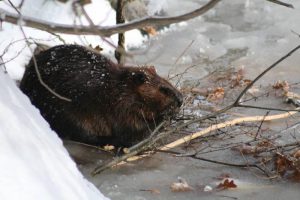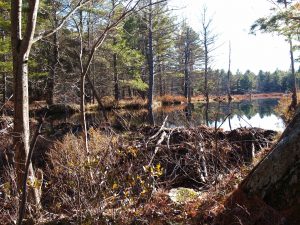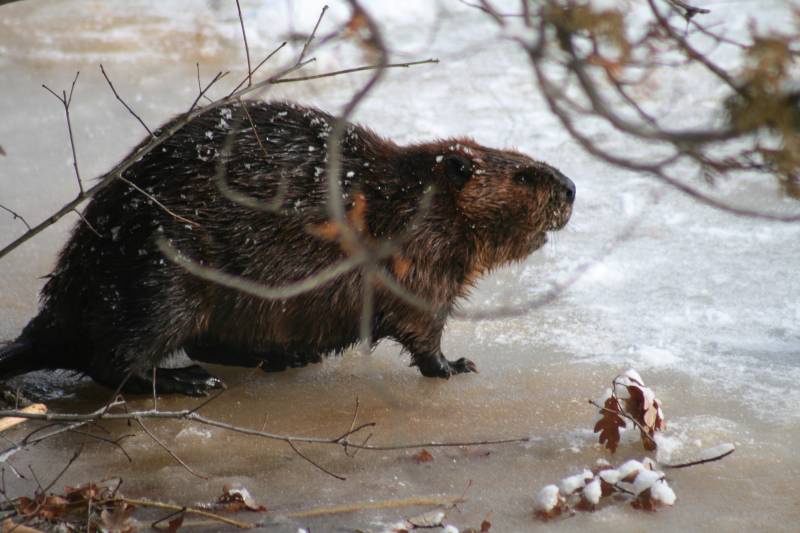FROM THE BICE PAPERS – Beaver and Why They Die (1976)
Scrapper is gone. He died suddenly, and the autopsy showed that he had had a heart attack.
So few will know just who Scrapper was. Scrapper was a beaver, not just an ordinary beaver, but THE beaver. This little animal was found three years ago as a very young, perhaps less than a week old kit, following a heavy flood that had no doubt washed out their home, and the helpless creature was washed away. When found he was barely alive, and just about the size of a squirrel.
He was given a home by Lloyd and Helen Cook of Barrie, who managed to coax it back to health, and with care the kindness raised it to be an adult beaver, weighing perhaps forty pounds. If people have been watching the half hour outdoor TV shows, no doubt they have seen Lloyd with this pet on the screen. They have taken it to the Trappers Convention the last three winters, and it has been a decided favourite of all who have seen it. I should have mentioned, in case anyone does not know, that Lloyd Cook is the very efficient President of the Ontario Trappers Association as well as President of the Canadian Trappers Federation. Scrapper has also appeared at many schools and other gatherings. The last time I saw him was during my brief stay in the hospital last summer, when visited by the Cook’s. Their car was parked near my window, and the beaver was allowed to run on the grass. Quite a crowd as usual gathered, and this tamed animal seemed to enjoy showing off. The Cook’s tell that the beaver seemed to think the house was his, and Lloyd and Helen were his family.
But he died so suddenly.
He did please a lot of people, both young and old who saw him, and since his habits could be so easily watched, there were more facts found out about Canada’s most famous animal. He will be greatly missed.
So many times beaver disappear, and no one seemed to know why. Intensive studies have shown that beaver can easily catch a disease, a type of tularemia.

This disease seems to strike when these animals get too plentiful. In fairly modern times it still happens. One case that was really bad was in northwestern Ontario in the mid-fifties. Beaver had become fairly plentiful, but trapping beaver in that area was not permitted. Then this disease struck, and the beaver population was all about eliminated. A program of re-stocking and wise management has restored them and there are many beaver in that area again.
But we do not have to go that far away to find where nature has taken over. It is almost fourteen years since I had my leg broken, and part of my own trapping area did not get bothered for a few winters. When I did get to visit those creeks, I was disappointed that there were no beaver. I got in touch with Dr. Rod Stanfield at the research station at Maple, and later Bill Elrington, top Conservation Officer at Bracebridge, and both informed me that it has been happening in a lot of places where beaver were not being harvested. The disease shows up in one colony, and then every colony on that creek is infected.
Stories we read about trapping years ago all told that heavy trapping just about eliminated the beaver in the late eighteen hundreds. Biologists now believe no doubt it was the disease as the woods were not so heavily trapped as now.
Beaver have moved to other areas. Some parts of the province they are considered a nuisance, and townships pay a bounty on them. In populated areas they do a lot of damage, flooding roads and fields, damning culverts, cutting trees down around summer cottages, even around permanent dwellings.
So beaver die for several reasons, over crowding, when nature takes over, and now we know they can have other causes for death. But one thing is certain. If the surplus crop is harvested the beaver population will stay healthy. To the groups who think trapping is a cruel method of keeping animals in balance we can only ask if they have ever seen any animal in the last stages of a natural death. I mean tularemia or rabies. The suffering they must endure in the final two weeks is much greater than a few hours even in the fast disappearing leg-hold trap. It is hard to understand why so many nature lovers think it is fit and proper for predators to kill smaller animals to keep nature in balance, but it is wrong for humans to do the same even when in many cases it is an economical necessity.
But beaver. They are really secure. When beaver season was opened in the late thirties we were taking about 20,000. The yearly average the last decade has been about 150,000, and shows no sign of declining. So all is well for Canada’s National Animal.

EDITORIAL NOTE
When he was President of the Ontario Trappers Association Lloyd Cook told me of an anti-trapping rally at Nathan Phillips Square in downtown Toronto. Cook walked up to the podium, took out one of the new traps, set it and put his hand in triggering the trap to close. He wanted to demonstrate how much more humane the traps were.
Retired C.O. Mike Evers – Canine Unit – told me that when Lloyd brought Scrapper into a room the beaver would check it out for an exit and then, once comfortable, would settle down and relax.
Lloyd had two Arctic fox and Helen insisted that he build them a dog house as they stayed out of doors. No matter how hard Lloyd tried to convince his wife that these were Arctic fox, accustomed to extremely cold weather sans housing, he eventually relented and built the structure. “Of course,” he told me, “they never used it.”

AND FINALLY…
He thought that he saw his eye doctor on an Alaskan Island but it turned out to be an optical Aleutian.
Photo – courtesy Donna Denier.
